|
|
Buildings and Edifices in Vienna
Vienna belongs to the modern cultural metropolis of Europe that attracts visitors from all over the world. This is not surprising, as beside the interesting royal history, at which one can take part by visiting the numerous palaces and museums, with its vivid cultural programe, Vienna repeatedely is a real magnet of audience. No matter if it is a laboriously arranged opera performance or as the Ring des Nibelungen at the Vienna State Opera, the theatre programe or the Opera Ball of Vienna. Those who do not visit Vienna due to its cultural highlights should be delighted "just like that" by the imposing coulisses. I collected on this page a small selection of imposing buildings and edifices for which planning a sidetrip to visit them in case of being interested is worthwhile. State Opera House of ViennaThe State opera House of Vienna that is located right at the Ringstraße in the centre of Vienna, counts to the most significant opera houses of the world. Together with the Skala of Mailand, the Metropolitan Opera of new York, the Opéra National de Paris and the State Opera of Munich, it represents the top of the opera houses. The house that was originally named k.k. Hofoperntheater was built in the years from 1861 to 1869 by the architects August Sicard von Sicardsburg and Eduard van der Nüll after they could obtain the tender for this first building at the Ringstraße that was financed by the city expansion fond of Vienna . 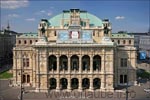
The musical tradition and history of this house always performed at a top level. World famous musicians managed the house: For example, Gustav Mahler, Richard Strauss ro also Herbert von Karajan. Also the musical cast of characters is, as usual, a conspicuous class of its own: beside Luciano Pavarotti and Placido Domingo, Anna Netrebko or also Maria Callas sung at the Opera of Vienna. Per year, there are approximately 50 performances where the whole repertoire of performances repeatedely change. What is in any case a highlight is the Ring des Nibelungen of Wagner that is performed as a monumental act during a whole week with each 1-2 days break between each of the operas. 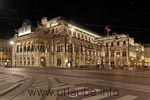
Beside the daily program consisting on opera, ballet or orchestra performance, there is a highlight every year during the fashing period that is celebrated in the State Opera House of Vienna: The Opera Ball of Vienna. This event that is visited by celebrities and a solvent clientele and has every year approximately 5000 guests. But the State Opera House of Vienna does not only attract the opera fans but also the very normal visitors of Vienna.The building is much too distinctive and much too showy to be ignored when passing it. The building komplex with the numerous side wings and ornaments is very fascinating. And what is specially attractive is the State Opera House of Vienna at night because it is then illuminated from all sides. As the Ringstraße in front of the opera is very wide, one can watch this light spectacle from a distance and only gaze. Court Theatre (Burgtheater)The building of the court theatre at the Dr.-Karl-Lueger-Ring is one of the most imposing edifices of Vienna and additionally, it counts to the most significant scenes of Europe. In the course of the arrangement of the Ringstraßen, Gottfried Semper and Karl Freiherr von Hasenauer designed, beside the castle theatre, also the art-historical and natural-historical museum, as also the new Hofburg. Within the castle theatre that is an imitation of the Semper Opera of Dresden, Gustav Klimt and his brother Ernst Klimt and also Franz Matsch are portrayed in the ceiling frescos. 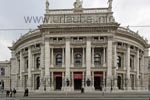
If one does not want to visit the theatre to see the performance, then it is worthwhile to take part in one of the guided tours that are offered almost every day and are held either in English as also in German language. By this way, one also has during the daytime an opportunity to gaze at this gorgeous arquitecture from the interior. What is really exciting is the conversion of the scene arrangement, as for example the way the ground or each of the coulisses get changed by elevating mechanisms. With its more than 1000 seats, the interior auditorium is one of the biggest in the world. Also the theatre scene extends in large dimensions. By this way, one looks through the 12 m wide scene gate to an expandable scene surface of approximately 1000 m². If actors like Klaus Maria Brandauer are on parade, the show becomes a highlight of a special kind. He and and some other top-class actors currently belong to the ensemble of the castle theatre of Vienna. Generally, due to the repertoire system that the castle theatre of Vienna offers provides a wide and alternating programe. Thus, more than 30 stage performances per season can be performed. UniversityThe current main building of the University is located at the Ringstraße of Vienna close to the Votivkirche (church) and was built in the time between 1877 and 1884 under the guidance of Heinrich von Ferstel. But the actual foundation history of the University of Vienna goes back up to the year 1365, whereby it belongs to the oldest history of University of the German language area. 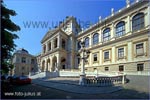
It took indeed some years until the University really started to work, but therefore, it was very successful. Due to some tutors who changed from the Sorbonne in Paris to the University due to some quarrels, from the year 1383 it was really crowded by students and up to the 14th century, the number of students raised to more than 6000. This was the time of prosperity of the University that ended abruptly by the siege of the turks and the religious division that not only ocurred in Vienna. A boom did not came until the year 1623 when the University was under the leadership of the jesuits. From the year 1749, a deep reorganization was supposed to take place by Maria Theresia and Joseph II. They could achieve that the influence of the jesuits completely disappeared nd the University was exclusively directed by the state. In the 19th century, numerous reforms led to a structural and topical rearrangement of the University service. Not only the faculties were reorganized but also women got the chance to study further in the university as students. City HallIn the 19th century, the original city hall at the Wipplingerstraße got much too small for the citizens requirements with the growing of new municipalities around Vienna. Thus, people were forced to find an areal on which the dimensions of the new city hall were large enough, also in the future. A total of 64 architects from Germany, Belgium, France, Italy and Austria took part in the tender of this project. In the year 1868, Friedrich Freiherr von Schmidt won the tender, who was already assigned as a German arquitect in the year 1859 in the Academy of Fine Arts in Vienna and who could make a name for himself as master builder of the Cathedral St. Stephan in the year 1863. 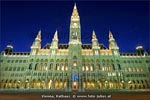
His neo-gothic building designed by himself was supposed to provide Vienna, with its prestigious interior, more prestige than it already had and could finally be inagurated in the year 1883. The monument built right in front of the royal theatre attracts with its abundantly adorned front cladding with figurines, arcades and lancet archs. The 5 towers which central tower rises up at a height of approximately 100 metres do almost remind one on a rather churchy building. The more than 1500 rooms of the city hall of Vienna are distributed in a basic ground of respectable 20.000 m². Up today, the city hall of Vienna is the domicile of the burgomaster and each of the bodies for the city and community, as also for the parliament and the land government. The forecourt of the city hall is a popular place for public arrangements, as for example the christmas market, public concerts or an open air cinema. ParliamentThe building of the parliament at the Ringstraße of Vienna reminds at first sight on a large greek temple. This tendence to an attic temple was supposed to relate to the greek beginnings of the democracy. In the building of the parliament, decisions concerning Austria are taken, here, the Austrian Nacional Council meets and from here, Austria is governed. 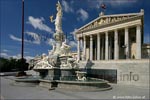
Not only the massive columns that dominate in the centric area but also for example the monument composition around the font at the front with the greek godess Athene support this impression that was lastly styled with caring delicate work to an oversized artwork. No wonder, as the arquitect of the parliament building of Vienna himself, Theophil von Hansen, he lived a couple of years in Athens and was a significant representant of the historism. With this style of art of the 19th century it was harked back to styles of art from long time ago and it was tried to imitate them. The construction works for the parliament building took from the year 1874 up to 1883. During the second world war, the building was strongly destroyed by the bombings. In the course of the years, it was tried to more or less keep in line with the original ideas of Hansen with other materials and each of the parts of the building were reconstructed. The parliament building receives its visitors in a new visitor centre. But what is much more interesting is the viewing of the building from the exterior. The stairs at the front part of the building invite to walk up and to a photo shooting. But it is hard to make good pictures of the parliment building as the dimensions are huge: even by standing at the opposite side of the Ringstraße it is hard to capture the whole dimensions of the building at one sight,not to mention to make a picture with the respective conoscopic lenses. Vienna International Centre (VIC), also called UNO-CityThe Vienna International Centre, or also called VIC, is better known amongst the local people under the name UNO-City. During the construction period from 1973 up to 1979, with the residence of the United Nations, the todays centre of the Danube City in the 22nd district of Vienna. 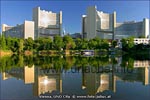
Thus, with the office of the United Nations, the fourth office of the UNO was originated in the year 1980 beside the ones in New York, Geneva and Nairobi. In total, more than 4000 people are in charge of international questions concerning the organization of the atomic energy, fight against crime, business law or aerospace. The Austrian arquitect Johann Staber planned this building in a total of 6 buildings that in their distinctive arrangement should shade each other as less as possible. The buildings can be viewed in guidances that are offered in several languages and where one can be informed about the different tasks of the UNO. But the best way to view the university city is from the neighboured Danube tower. From the height it is possible to capture the whole building complex and thus recognize easily how each of the buildings are arranged to each other. Danube Tower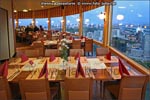
The Danube Tower of Vienna is an observation deck, café and restaurant at the same time. During the short construction period between 1962 and 1964, one of the highest buildings of Austria was originated with a height of 252 metres amidst the 22nd city district Donaustadt. The tower that advanced to be the emblem of Vienna attracts every year half a million visitors on an observation terrace at a height of 150 metres. From here, one has a fantastic panorama view over the whole of Vienna and provided the weather is fine, one has a view within a circumference of 80 km. Since the year 1964, the two lifts that transport the visitors upwards within seconds belong to the fastes ones of Europe. 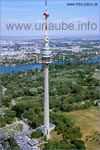
At the upper side of the terrace there is a café and a restaurant at a height of 160 and 170 metres. The special thing of both is that any 60 minutes, they turn through 360°. In the evening hours, we sat in the café and had a wonderful view to the illuminated city. It is incredibly fascinating to follow the streets from this height and to stand on the turning platform in such a height. The amazement doesn't stop. But this does not mean that due to this one forgets to enjoy the delicious cake. Thus, not only the view of the tower is highly recommendable but also the comfortable atmosphere of the café with its delicious specialities of Vienna. 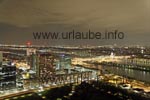
Those who want to top this with another highlight can visit the Danube Tower in the moonlight, dares the bungee jump or celebrates his wedding in this unusual place. We indeed did not make use of these extra events, but we still kept the Danube Tower in special memory. Those who are free from giddiness and do not care about the entrance fee for the lift can enjoy an unforgettable view. But one thing must be clear to the visitor of the observation deck: up there, there is a very strong wind, even if down in the ground it is almost windless. In case of a very strong wind, the stay on the open air platform can be very unpleasant, then it is better to view Vienna from the second platform that is protected by glass walls. In case of a very strong wind, the outer platform is closed for the visitors for security reasons. 
Copyright 2007-2008: Patrick Wagner, www.tourist-guide.biz |
||